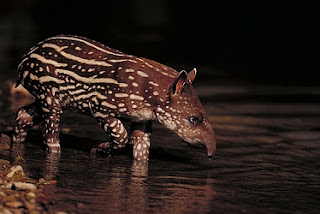Animal Wildlife | Brazilian Tapir | brazilian rainforest, brazilian art, endangered tapir, tapir endangered, brazilian culture, brazilian rainforest animals, brazilian animals, brazilian nuts - The South American Tapir (Tapirus terrestris), or Brazilian Tapir (from the Tupi tapi'ira) or Lowland Tapir or (in Portuguese) Anta, is one of four species in the tapir family, along with the Mountain Tapir, the Malayan Tapir, and Baird's Tapir. It is the second largest land mammal in South America, after Baird's Tapir. The Brazilian Tapir (also known as the South American Tapir) is known to be a fantastic swimmer and the Brazilian Tapir is generally found close to water in the Amazon Rainforest.
It is dark brown in color, paler in the face, and has a low, erect crest running from the crown down the back of the neck. The round, dark ears have distinctive white edges. The South American Tapir can be found near water in the Amazon Rainforest and River Basin in South America, east of the Andes. Its range stretches from Venezuela, Colombia, and Guianas in the north to Brazil, Argentina, and Paraguay, in the south, to Bolivia, Peru, and Ecuador in the West.
It is an herbivore animal. Using its mobile snout, this tapir feeds on leaves, buds, shoots, and small branches that it tears from trees, fruit, grasses, and aquatic plants.
The social life of the South American tapir is unknown. In the San Diego zoo, the captive group forms a structured herd, with dominant and subordinate animals of both sexes. The dominant male and female make what is called the 'sliding squeal', less than a second in duration. On hearing this sound the others make a 'fluctuating squeal', which is longer and quavers rather than merely decreasing in pitch. This is also uttered when a dominant individual approaches, apparently as an appeasement call and as a sign of pain or fear. Tapirs also utter a challenging snort, and a click made with the tongue and palate, perhaps as a species identification. - Animal Wildlife







Hi all,
ReplyDeleteThe Brazilian Tapir is the smallest species and the heaviest individuals weigh only 400 pounds. It is plain brown, often with whitish lips and ear-tips, and grey tones on the throat, different races are predominantly black, brown or grey. The top of the head is flat, the midline of the neck is raised and fleshy, and there is a short stiff mane along it. The newborn young weigh only 9 pounds. Thanks a lot....
Wildlife Photography